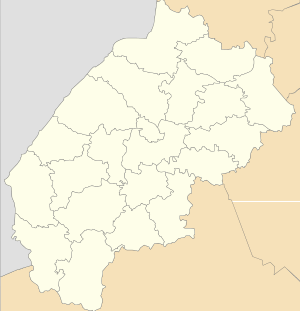Yavoriv
Yavoriv (Ukrainian: Яворів, Polish: Jaworów, Yiddish: יאַוואָראָוו Yavorov) is a city located in Lviv Oblast (region) of western Ukraine near the Polish border. It is the administrative center of Yavoriv Raion and rests approximately 50 kilometres (31 miles) west of the oblast capital, Lviv. Its population is approximately 13,057 (2017 est.)[1].
Yavoriv Яворів | |
|---|---|
City | |
Yavoriv city hall | |
 Coat of arms | |
 Yavoriv  Yavoriv | |
| Coordinates: 49°56′49″N 23°23′35″E | |
| Country | |
| Oblast | |
| Raion | |
| Founded | 14th century |
| Magdeburg law | 1569 |
| Area | |
| • Total | 23.35 km2 (9.02 sq mi) |
| Elevation | 296 m (971 ft) |
| Population (2013) | |
| • Total | 12,905 |
| • Density | 569.050/km2 (1,473.83/sq mi) |
| Time zone | UTC+2 (EET) |
| • Summer (DST) | UTC+3 (EEST) |
| Postal code | 81000 |
| Area code(s) | +380-3259 |
Not far from it is the watering-place of Shklo with sulfur springs.[2]
History
The town was first mentioned in written documents in 1376, when it belonged to the Duke of Opava and Racibórz, Wacław. It received Magdeburg rights in 1569, from King Sigismund II Augustus. It was a favorite residence of king John III Sobieski, who there received the congratulations from the Pope on his success against the Turks at Vienna (1683).[2]
Until the Partitions of Poland, Jaworów was an important center of commerce, located along main merchant route from Jarosław to Lwów. In 1772 it was annexed by the Habsburg Empire, as part of Austrian Galicia, where it remained until late 1918. In Galicia, it was the seat of a county, with the population of almost 11,000 (Poles, Jews, Ukrainians and Czechs).
In the immediate post-World War I period, the area of Jaworów witnessed Polish – Ukrainian fighting (see Polish-Ukrainian War). After the war, the town became part of the Second Polish Republic, where it remained until the Invasion of Poland in September 1939.The Jews of the village were merchants or artisans. There was a synagogue.
The Jewish population before the German occupation on June 26, 1941 was around 3000. Immediately after the Germans arrived, antisemitic Ukrainians launched a pogrom, robbing and killing Jews. German forces took 15 Jews to a nearby forest and shot them. After that, for several months, Jews lived in their own homes but were banned on the main street and had a 6 pm curfew. The Ukrainian police brutalized them, with beatings and some plunder and rape. Several hundred Jews were sent to local forced labor camps. In November 1942, German security forces, along with German and Ukrainian police, rounded up 1200 Jews, killed 200 on the spot, and sent the others to the Belzec killing camp where they were immediately murdered. A few days later, German and Ukrainian police hunted Jews in hiding and murdered about 200 at the Jewish cemetary. After that, the Germans established a Jewish ghetto which housed about 600 Jews. Soon after, Jews from a few neighboring villages were brought to Yavoriv bringing the ghetto population to 6000. More than 70 people lived in each of the 80 small houses in the ghetto. The overcrowding, starvation, and poor sanitary conditions soon led to a typhus epidemic. After about 500 more able-bodied Jews were sent to a labor camp, on April 16, 1943, the German and Ukrainian police took more than 3500 Jews to the Porudno forest and murdered them. More than 2500 Jews were murdered before noon on the 16th, the rest over the next few days. The Germans and Ukrainians burned the ghetto and searched for those in hiding. Those found were shot. A few were transferred to a labor camp in Lwow. [3]
After the war, the Soviet Extraordinary State Commission reported that more than 4900 people, most of them Jews, had been killed in Yavoriv, in addition to those sent to Belzec. Only about 20 of the town's Jews were thought to have survived. For a report on Yavoriv (Jaworow) during the war, see Megargee's Encyclopedia of Camps and Ghettos.[4]
Among notable people born here are Władysław Langner (General of the Polish Army), Stanisław Nowakowski (president of the Polish Scouting and Guiding Association), and mathematician Wawrzyniec Żmurko.
Gallery
.jpg) Lvivska Street in Yavoriv
Lvivska Street in Yavoriv.jpg) Saints Peter and Paul church
Saints Peter and Paul church- People's House in Yavoriv
International relations
Twin towns — Sister cities
Yavoriv is twinned with:
| City | Country | Year |
|---|---|---|
| Jarosław | 2006 | |
| Węgorzewo | ||
| Lubaczów | ||
| Trakai |

See also
- Battle of Jaworow
References
- "Чисельність наявного населення України (Actual population of Ukraine)" (in Ukrainian). State Statistics Service of Ukraine. Retrieved 26 August 2017.
-

- http://yahadmap.org/#village/yavoriv-lviv-ukraine.347
- Megargee, Geoffrey (2012). Encyclopedia of Camps and Ghettos. Bloomington, Indiana: University of Indiana Press. p. Volume II 784-686. ISBN 978-0-253-35599-7.